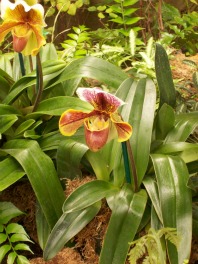Paphiopedilum Orchid Species and Hybrids
How to Care for Lady Slipper Orchids
They grow in humus and other material located on the forest floor, on cliffs in pockets of humus, and some species grow in trees.
Blooms can last for eight weeks or longer, and are comprised top and side petals that frame a pouch, or “slipper”.
They are easy to grow in the home, under lights, or in a greenhouse.
Flower
Paphiopedilum orchids are referred to as Lady Slipper orchids
 because their lip is
shaped like the toe of a slipper.
because their lip is
shaped like the toe of a slipper.The unique flowers are available in variety of colors, shapes and sizes.
Due to their wax-like appearance, they often appear more artificial than real.
Flowers may be solitary or in small clusters in many colors. Most bloom in fall and winter.
The blooms can last for up to eight weeks or longer.
Paphiopedilum Orchid Care Tips
Lighting RequirementsModerate year-round. Paphiopedilum species require shady conditions. In the home, place this orchid in a shaded window. Fluorescent lighting is acceptable in the home. In the greenhouse, shade should be provided.
Temperature Requirements
Intermediate (65 - 70° F / 18 - 21° C nights and 80 - 85° F / 27 - 29° C days) Year Round.
Humidity Requirements
Forty to fifty percent humidity is ideal for paphiopedilum orchids. This can be provided by placing the orchid pot on a tray of gravel filled with a small amount of water or by placing a humidifier in the room. A greenhouse should also provide sufficient humidity.
Fertilizer
Fertilize every third watering during spring and summer - fertilizer should be mixed at ½ the strength. Feed every three weeks in fall and winter – dilute fertilizer to ¼ the strength.
Tip: To prevent and remove excess salts from potting soil, thoroughly flush with clear water every month.
Water
Keep medium evenly moist at all times (not soggy). Be sure water reaches the roots since this orchid does not have pseudobulbs. Watering schedule is typically once or twice a week.
Soil
Orchid Potting Mix
Propagation
As plant matures, small offsets will appear at the base of the orchid. These offsets can be removed and repotted. You can also wait for the plant to form large clumps, and separate by division – typically every four to five years.
Repotting
- Cover a flat work space with butcher paper or newspaper. To loosen the orchid, tap the pot gently or slide a knife between the soil and the pot.
- Tilt the orchid pot sideways and gently remove the plant from the pot and lay it on the work surface.
- Gently remove as much of the potting mix from the orchid roots as possible. Check the root system for sick or damaged roots. Unhealthy roots need to be trimmed off.
- The best pot will be slightly larger than the current one, one large enough to allow the orchid to continue to grow, as well as allow for air circulation around the root system.
Note:
It should comfortably accommodate the roots without crowding. An orchid
pot that is too large allows moisture to remain in the soil mix and
will cause root rot.
- Potting medium for paphiopedilum orchids use a combination of bark and soil. Choose a fine bark - avoid medium or large chunks. Four parts fir bark to one part perlite is recommended.
- Position the orchid in the pot so its base aligns with the edge of the pot. Position older growth closer to the edge of the pot - new growth should be positioned towards the center.
- Water the plant when new growth is established. Ensure plant is adequately hydrated; spray the leaves to maintain humidity. As new growth occurs, keep the plant shaded. When the new growth appears to be established, move the orchid into bright, indirect light.
Longetivity
Paphiopedilum orchids can last many years when propagated from plantlets.
Selection
Hybrids grow slightly faster than many species, as well as flower frequently.
Uses and Display Tips
Paphiopedilum orchids are elegant when planted in a simple flower pot, which can be displayed in a location that receives bright, indirect light.
Other Types of Orhcids
| Cattleya Orchids - Large Stunning Blooms |
| Cymbidium Orchids - Long-Lasting Flowers |
| Dendrobium Orchid - Arching Displays of Beautiful Flowers |
| Oncidium Orchid - Colorful Exotic Blooms |
| Phalaenopsis Orchid - Elegant Long-Lasting Flowers |





